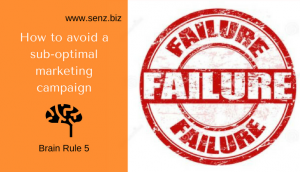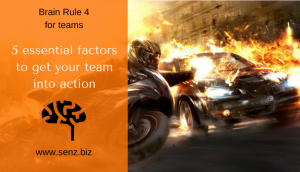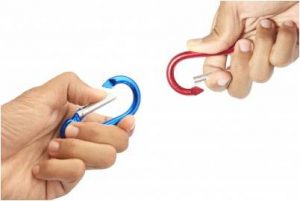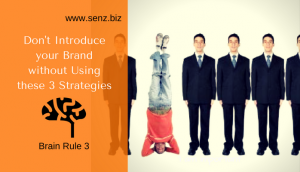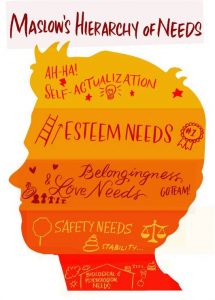- Home /
- strategies
Brain Rule 5 – to turn failure into success

How to avoid a sub-optimal marketing campaign
Many marketing-campaigns are sub-optimal. This article covers the 5th brain rule, a very basic one, but many marketers forget to use it in their brand strategy and therefore lose many clients.
Why do people show up at the event of your competitors and not at yours? Why don’t they buy your new vitamin product or invest in your new technology?
Psychology plays a big part when people make a decision. Offering pleasure and a better future is not a main driver to getting them into action. That’s why you shouldn’t focus on pleasing your clients.
What kind of person is most likely to buy a hamburger? Right, somebody who is hungry! Not the people who just like hamburgers or those who have had hamburgers in the past. Although those last two groups could be good leads, too. They need to be hungry… So what does this mean?
Let me give you another example.
Who is most likely to buy your weight management product? An overweight man or a lady who needs to fit into her evening dress to meet her new lover? It’s the lady. Why? Because, like the man who is hungry, she is facing a problem, that she wants to solve.
Avoiding immediate pain is much more motivating than gaining immediate pleasure. This means that, talking about the direct benefits of your product will not immediately grab people at first. When do you immediately take action? Not if you are promised something nice in the future. You take action if you want to move away from a negative situation.
Problems (pains) trigger our urge to survive and make us take action
The 5th Brain Rule says: Focus on the Pain, not on the Pleasure
Your reptilian brain, that takes the decisions, wakes up if there is a problem. It will tell you: be careful, danger! And will immediately be alerted and take action in order to survive.
The 5th brain rule is related to the most basic of all Mazlow’s needs: the need to survive. Haven’t you heard about Mazlow, yet? Read the first brain rule to learn more. The need for survival is the need for food, drink, shelter, sleep and oxygen. If you are cold, sick or hungry you will do your utmost to change this situation.
So, what can you do take bring this rule into practice?
How can you make people decide for your brand, event, therapy, company or hospital, using brain rule 5?
1 Describe the real PAIN
You can press the Survival Button of your clients by describing their pain.
Domino’s Pizza shows a good example. They knew that their consumer’s true pain was not that they didn’t have pizza. The real pain was in not knowing when the pizza would arrive. By installing an online ordering system that tells you exactly when your pizza is on its way, they increased sales exponentially.
So, find out what the real pains of your ideal client are. Ask them, search which posts have many reactions, check which books on your topic score high on Amazon. Mention their problems in your communication, so they will feel understood and feel the urge to take action.
2 Translate your USP’s into Survival Triggers
Translate your USP’s into the impact it has on financials, time, relationships, health or happiness. These have a real impact on your clients.
For example: a kidney clinic helps clients to improve their lifestyle. That’s a USP. How can you translate this into survival triggers? Improved lifestyle can result in less dependence on others and therefore improved happiness. Less dependence on others is a stronger trigger than an improved lifestyle. Also improved mobility and less time that you need to spend on check-ups are strong triggers.
3 Create Scarcity and Urgency
Show your clients that they need to be fast in order to not miss out on your offer.
How this works? Your survival button is pressed when something is taken away from you. You will immediately take action. May be you have heard of FOMO before: The Fear Of Missing Out. This is one of the most impactful psychological strategies you can use to increase the success of your marketing efforts and brand promotion.
People hate it if they miss out of something. A study states that 69%of millennials feel a fear of missing out when they cannot attend some sort of event. This applies to users of all age groups!
So, use phrases like:
Don’t miss out
Only 10 places left
Tomorrow higher price
4 Create Contrast
Be very clear about where you are different than others. This makes it very easy for potential clients to choose for you. This can be done by a contrast-rich description versus the competition, but even better by a picture.
Our reptilian brain, which takes the decisions, is very alert to contrast. Our forefathers were alerted to a sudden movement in a calm landscape or any other change. This helped them to survive.
Brain Rule 5 triggers your customer’s need to survive. This makes them take action. So, it is not about listing the mode of action of your product, what kind of services you offer or even your USP’s. Knowing and listing your customer’s problems triggers them. And offering them a scarce solution that they should pick urgently helps them make up their mind. Apply brain rule 5, help your clients solve their problems and create a unique position!
Do you know more ways to trigger the need to survive? Share them in the comments.
Want to learn more ways to build a leading market position? Click here:
How you add 95% to your influential power
3 Do’s & Don’ts to engage your customers
Don’t introduce your brand without using these 3 strategies
10 ways to increase your revenue through trust
With survival greetings,
Karin
Senz – brand positioning & client attraction, www.senz.biz
p.s. Want more strategies to build a leading market position in the healthcare or services market? Click here to get access to our FREE resources with the newest marketing strategies and Senz & Brain Tips
5 essential factors to get your team into action

Brain Rule 4 for Teams – to make your team follow you
We do not trust our boss! In the corridor employees are complaining: ‘The direction of the company is not clear’, ‘we don’t believe what our manager says.’ Or ‘beautiful plans to build the brand, but the reality is very different.’ It may frustrate you that your employees don’t get it and don’t take the required action. Apply brain rule 4 to make your team trust and follow you.
The problem may be that a consistent message, that touches them, is missing. People need clarity and guidance. Probably, you remember the feeling that something is not right, if somebody tells you a lie. The first thing that happens is that your brain warns you that you are in danger. It starts producing a strain of counter-arguments.
Safety is one of the core needs. If insecurity and danger and therefore anxiety arise, this leads to action; but not in the right way. It leads to either fight or flight. Fight in this case means: working harder, or show that you are more important than others; and internal competition. Flight means: if they don’t see or hear me, nothing will happen. I just do my own thing and do not show myself.
Internal conflicts, stress and slowdown are the result. This unproductive process is going on in many companies. So, how can you deal with this as a leader?
Consistent messages that create a feeling of safety, inspire teams (and clients) to follow you. Subconscious counter-productive mechanisms in your brain will be over-ruled. Some leaders happen to be the ones that are followed by many people. They inspire their environment, so many team members feel the drive to perform. You can also make this happen!
Brain Rule 4 says: Establish a Safe Setting
This is important for clients, as well as for employees.
Read the 10 easy ways to make clients trust you and increase your credibility (and revenues).
These are the 5 essential factors how you can make your team trust you, and get into action.
1. Be the living example of your message! A big desire of employees is to have a role model, somebody to identify themselves with. However, if they receive different conflicting signals, people will get confused. Like in a company where the CEO told his team that customer orientation needs to be improved. Every day, he parked his car at the place for… clients! So, do what you pray!
2. Be consistent yourself; match your feeling, thinking and behavior. I remember a meeting where a manager jumped up with a red face and started to defend his point of view. One of the team members noticed: you seem to be very angry at us. He shouted: I am not angry. With denying your feelings, you may seem a rational leader, but you actually betray yourself; and others.
Other people immediately notice what is going on. This is due to your mirror-neurons in your brain. These are nerve-cells that notice and mirror the emotional state of mind of others. This means that your team members will immediately feel what you feel. So, realize what you really feel and think while you are sending a message. And be honest: do they match with each other?
3. Let your heart speak! This has an amazing effect! Without feeling, no passion. Without passion, no action. Managers need awareness of their own feelings as a precondition for effective leadership. This way, they will be perceived as authentic and trustworthy.
4. Listen to your team members. Recognition creates a safe environment and takes away 50% of all problems.
5. Send at least 7 consistent messages about the same topic (of course in a slightly different way). You may know that you need this to help prospects take action. However, the same is valid within your organization. You will immediately notice the effect.
Implement brain rule 4 and establish a safe setting for your team by speaking and acting from your heart. This makes them follow you and take action.
Do you know more ways? Share them in the comments.
With trustworthy greetings,
Karin
Senz – brand positioning & client attraction, www.senz.biz
p.s. Want more strategies to build a leading market position in the healthcare or services market? Click here to get access to our FREE resources with the newest marketing strategies and Senz & Brain Tips
7 strategies to turn negativity & passiveness into initiative
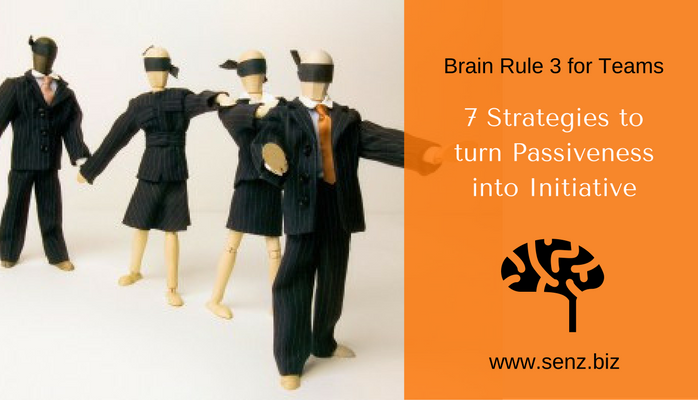
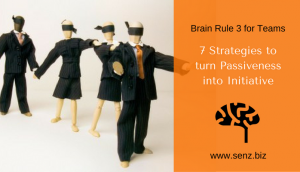
Brain Rule 3 for teams: to Increase the Initiative in your Team
Your employees are complaining that there is a lack of direction. They don’t feel motivated anymore.
Especially now, it’s important that they take initiative and do a better job than ever before.
Brain Rule 3 helps you get the initiative back in your team and increase the productivity.
As a leader you feel that your strategy is clear and you don’t understand why your employees don’t get it. Sales are lacking behind and something needs to happen. Otherwise, it is even necessary to start a re-organization and dismiss people.
You have tried a lot: you spoke with them, gave them clear assignments and maybe even a training. However, nothing really changed.
What is going on?
-Your employees really don’t know the direction. Leaders think that everybody knows it, but this is NOT the case. Research (CIPD) showed that out of 2000 employees only 29% knew the values and strategies of their company.
-It could well be that your team feels that the management goes into a direction they do not want to identify with
-Or maybe some of your team members know that they are nominated to be dismissed
-Or they feel that they are not valued anyhow
In all cases, this means that the connection between your employees and the company is lost. They do not feel that they belong to the company anymore (although they are employed).
You are not meeting one of the strongest forces in universe: ‘social belonging’. The importance of belonging to a group is not always immediately recognized. However, it has disastrous consequences for a company if this aspect is lacking. Our mental system is programmed to belong to a group. If this does not happen, our brain sends signals that feel like a punishment.
This leads to negativity, passivity, feelings of burn-out and demotivation. The loyalty to the company will drop with a negative impact on sick leave, employee turnover and productivity.
This can last for months and even years. No wonder that the clients feel this; with a negative effect on the bottom-line.
So, how can you get all noses into the same direction?
How can you make everybody feel responsible and take action?
How can you turn negativity & passiveness into initiative?
Restore the connection and make use of:
Brain Rule 3 for teams: create a sense of belonging
This is a proven recipe
Click here if you want to know how you can use brain rule 3 for clients.
7 strategies for leaders to turn negativity & passiveness into initiative:
1. Make clear what you stand for and what is your strategy
Communicate this message consistently and show it in actions. In the end, nobody wants to stay behind.
2. Be even clearer about what you expect of your employees.
Tell them what their added value is. Even in a period of re-organisation.
3. Create an enthusiastic (and big enough) group of pioneers, if you want to introduce new strategies.
Others will follow.
4. Mention the commonalities in your team and make clear where you are different than others.
People always prefer their own group above others.
5. Make clear to what group they belong if they take the wished actions.
Make also clear that you are also part of the group and lead by example.
6. Set concrete short-term objectives, so everybody can immediately notice the effect.
This way, you are positively influencing the intrinsic motivation, satisfaction and output. This does not work with abstract objectives that are too far away.
7. Give regular feed-back about the progress that has been made.
This way, people function in the best way (Amabile, Harvard University).
Do you know more strategies? Share them in the comments.
If you implement brain rule 3 in your team, you will immediately notice the impact on the productivity, teamwork and motivation. If this is lacking, this will lead to loads of stress, dissatisfaction and demotivation.
With connecting greetings,
Karin
p.s. Want more strategies to build a leading market position? Click here to get access to our FREE resources with the newest marketing strategies and Senz & Brain Tips
Brain Rule 3 – don’t Introduce your Brand without Using these 3 Strategies
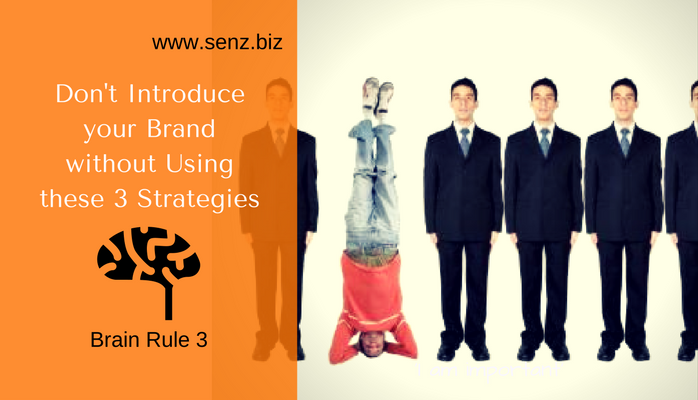
Brain rule 3 – to make clients love your brand
The whole day, your clients are influenced by millions of triggers. So, how do you get into the mind & heart of your clients, if you are one out of millions? How can you make clients love your brand?
Brain Rule 3 plays an important role!
The good news is that our reaction to triggers is programmed in our brain. Scientists do not know yet how it all works, but what they know is that it started long ago.
This makes me think of the following cartoon:
A HR-manager asks a monkey:
Do you want a salary increase of 100%, 20 extra free days, a pension and a bonus of 100.000 Euro?
Or do you want this banana?

Oh dear, the monkey chooses subconsciously for the banana!
We are 100% similar to this monkey. Also we, and our clients, follow our primitive urges.
Successful marketers and leaders acknowledge these primitive urges and deeper needs of people.
This time, we take a look at one of the most important needs of people, one of the strongest powers in the universe.
Why do you hear laughing during comics?
Why do you follow the latest fashion trends?
Why do you take a look at your neighbor if you don’t know how to use your cutlery?
We are programmed to stick together. Every person subconsciously wants to be part of a group, which has something in common; really, also you. ‘Belonging to a group’ and being a valuable group member, is a matter of live or die. If you deviate from the majority, your brain will release a signal, which feels like a punishment.
This is a very important brain-principle, which drives our behavior; and a very strong element to attract clients. Our need to belong to a group is so big that people even decide to connect to sects, radical groups and terroristic gangs. This brings us to Brain Rule 3.
Brain Rule 3: Create a group of like-minded clients
This rule is closely related to Mazlow’s need to belong.
Having solid social connections can be as important to human health and happiness as having food, water, and shelter. Research shows that your odds of survival increase by 50% by having social relationships. This effect is comparable to the effects of smoking and excessive drinking on mortality, suggesting that having quality social ties is vital to our lives.
Okay, let’s list the 3 strategies to tap into the need of social belonging:
1. Focus on a specific group of people and share who they are.
Most likely to buy your products are people who share the same personality, beliefs and the same WHY with you.
2. Make clear what makes you different than others.
People love their own group more than others.
3. Share who is already buying/liking you.
People with the same profile are likely to follow.
This is a great example how Brain Rule 3 works. Want to try?
A hotel tested several messages to make guests use their towel more than once. Which one had most effect?
1. Help the hotel save energy
2. Let’s together save the environment
3. Just like other guests, help to save the environment
4. Just like other guests, help to save the environment (75% of the guests in this room participated in our savings-program)
5. Use our energy sources sparingly, think about our future generation
6. Help to save the environment
This is how people will start loving your brand. They will feel it’s their brand, since it says so much about them. Ogilvy calls them Lovemarks; and Lovemarks transcend brands. They reach your heart as well as your mind, creating an emotional connection that you just can’t live without.
Take a brand away and people will find a replacement. Take a Lovemark away and people will protest its absence. Lovemarks are a relationship, not just a transaction. You do not just buy them, you embrace them passionately. That’s why you never want to let go.
It is clear that using brain rule 3 creates Brand Love and Brand loyalty, which can be very profitable.
Do you know more ways to implement Brain Rule 3: Share them in the comments.
With love,
Karin

